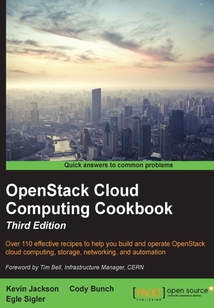舉報 

會員
OpenStack Cloud Computing Cookbook(Third Edition)
最新章節:
Index
OpenStackOpenSourcesoftwareisoneofthemostusedcloudinfrastructurestosupportsoftwaredevelopmentandbigdataanalysis.Itisdevelopedbyathrivingcommunityofindividualdevelopersfromaroundtheglobeandbackedbymostoftheleadingplayersinthecloudspacetoday.Itissimpletoimplement,massivelyscalable,andcanstorealargepoolofdataandnetworkingresources.OpenStackhasastrongecosystemthathelpsyouprovisionyourcloudstorageneeds.AddOpenStack'senterprisefeaturestoreducethecostofyourbusiness.Thisbookwillshowyouthestepstobuildupaprivatecloudenvironment.Atthebeginning,you'lldiscovertheusesofcloudservicessuchastheidentityservice,imageservice,andcomputeservice.You'lldiveintoNeutron,theOpenStackNetworkingservice,andgetyourhandsdirtywithconfiguringML2,networks,routers,andDistributedVirtualRouters.You’llthengathermoreexpertknowledgeonOpenStackcloudcomputingbymanagingyourcloud'ssecurityandmigration.Afterthat,wedelveintoOpenStackObjectstorageandhowtomanageserversandworkwithobjects,cluster,andstoragefunctionalities.Also,asyougodeeperintotherealmofOpenStack,you'lllearnpracticalexamplesofBlockstorage,LBaaS,andFWaaS:installationandconfigurationcoveredgroundup.Finally,youwilllearnOpenStackdashboard,AnsibleandForeman,Keystone,andotherinterestingtopics.
目錄(151章)
倒序
- coverpage
- OpenStack Cloud Computing Cookbook Third Edition
- Credits
- Foreword
- About the Authors
- About the Reviewers
- www.PacktPub.com
- Support files eBooks discount offers and more
- Preface
- What this book covers
- What you need for this book
- Who this book is for
- Conventions
- Reader feedback
- Customer support
- Chapter 1. Keystone – OpenStack Identity Service
- Introduction
- Installing the OpenStack Identity Service
- Configuring OpenStack Identity for SSL communication
- Creating tenants in Keystone
- Configuring roles in Keystone
- Adding users to Keystone
- Defining service endpoints
- Creating the service tenant and service users
- Configuring OpenStack Identity for LDAP Integration
- Chapter 2. Glance – OpenStack Image Service
- Introduction
- Installing OpenStack Image Service
- Configuring OpenStack Image Service with OpenStack Identity Service
- Configuring OpenStack Image Service with OpenStack Object Storage
- Managing images with OpenStack Image Service
- Registering a remotely stored image
- Sharing images among tenants
- Viewing shared images
- Using image metadata
- Migrating a VMware image
- Creating an OpenStack image
- Chapter 3. Neutron – OpenStack Networking
- Introduction
- Installing Neutron and Open vSwitch on a dedicated network node
- Configuring Neutron and Open vSwitch
- Installing and configuring the Neutron API service
- Creating a tenant Neutron network
- Deleting a Neutron network
- Creating an external floating IP Neutron network
- Using Neutron networks for different purposes
- Configuring Distributed Virtual Routers
- Using Distributed Virtual Routers
- Chapter 4. Nova – OpenStack Compute
- Introduction
- Installing OpenStack Compute controller services
- Installing OpenStack Compute packages
- Configuring database services
- Configuring OpenStack Compute
- Configuring OpenStack Compute with OpenStack Identity Service
- Stopping and starting nova services
- Installation of command-line tools on Ubuntu
- Using the command-line tools with HTTPS
- Checking OpenStack Compute services
- Using OpenStack Compute
- Managing security groups
- Creating and managing key pairs
- Launching our first cloud instance
- Fixing a broken instance deployment
- Terminating your instances
- Using live migration
- Working with nova-schedulers
- Creating flavors
- Defining host aggregates
- Launching instances in specific Availability Zones
- Launching instances on specific Compute hosts
- Removing Nova nodes from a cluster
- Chapter 5. Swift – OpenStack Object Storage
- Introduction
- Configuring Swift services and users in Keystone
- Installing OpenStack Object Storage services – proxy server
- Configuring OpenStack Object Storage – proxy server
- Installing OpenStack Object Storage services – storage nodes
- Configuring physical storage for use with Swift
- Configuring Object Storage replication
- Configuring OpenStack Object Storage – storage services
- Making the Object Storage rings
- Stopping and starting OpenStack Object Storage
- Setting up SSL access
- Chapter 6. Using OpenStack Object Storage
- Introduction
- Installing the swift client tool
- Creating containers
- Uploading objects
- Uploading large objects
- Listing containers and objects
- Downloading objects
- Deleting containers and objects
- Using OpenStack Object Storage ACLs
- Using Container Synchronization between two Swift Clusters
- Chapter 7. Administering OpenStack Object Storage
- Introduction
- Managing the OpenStack Object Storage cluster with swift-init
- Checking cluster health
- Managing the Swift cluster capacity
- Removing nodes from a cluster
- Detecting and replacing failed hard drives
- Collecting usage statistics
- Chapter 8. Cinder – OpenStack Block Storage
- Introduction
- Configuring Cinder-volume services
- Configuring OpenStack Compute for Cinder-volume
- Creating volumes
- Attaching volumes to an instance
- Detaching volumes from an instance
- Deleting volumes
- Configuring third-party volume services
- Working with Cinder snapshots
- Booting from volumes
- Chapter 9. More OpenStack
- Introduction
- Using cloud-init to run post-installation commands
- Using cloud-config to run the post-installation configuration
- Installing OpenStack Telemetry
- Using OpenStack Telemetry to interrogate usage statistics
- Installing Neutron LBaaS
- Using Neutron LBaaS
- Configuring Neutron FWaaS
- Using Neutron FWaaS
- Installing the Heat OpenStack Orchestration service
- Using Heat to spin up instances
- Chapter 10. Using the OpenStack Dashboard
- Introduction
- Installing OpenStack Dashboard
- Using OpenStack Dashboard for key management
- Using OpenStack Dashboard to manage Neutron networks
- Using OpenStack Dashboard for security group management
- Using OpenStack Dashboard to launch instances
- Using OpenStack Dashboard to terminate instances
- Using OpenStack Dashboard to connect to instances using a VNC
- Using OpenStack Dashboard to add new tenants – projects
- Using OpenStack Dashboard for user management
- Using OpenStack Dashboard with LBaaS
- Using OpenStack Dashboard with OpenStack Orchestration
- Chapter 11. Production OpenStack
- Introduction
- Installing the MariaDB Galera cluster
- Configuring HA Proxy for the MariaDB Galera cluster
- Configuring HA Proxy for high availability
- Installing and configuring Pacemaker with Corosync
- Configuring OpenStack services with Pacemaker and Corosync
- Bonding network interfaces for redundancy
- Automating OpenStack installations using Ansible – host configuration
- Automating OpenStack installations using Ansible – Playbook configuration
- Automating OpenStack installations using Ansible – running Playbooks
- Index 更新時間:2021-07-16 20:39:47
推薦閱讀
- 自己動手寫搜索引擎
- Python機器學習:數據分析與評分卡建模(微課版)
- Python從菜鳥到高手(第2版)
- Bootstrap 4:Responsive Web Design
- INSTANT OpenNMS Starter
- Modular Programming in Java 9
- 編程數學
- HTML5與CSS3基礎教程(第8版)
- Scala Data Analysis Cookbook
- Python爬蟲、數據分析與可視化:工具詳解與案例實戰
- Mastering Akka
- Machine Learning With Go
- .NET 4.5 Parallel Extensions Cookbook
- Java7程序設計入門經典
- H5+移動營銷設計寶典
- AutoCAD基礎教程
- SQL Server實例教程(2008版)
- 軟件開發中的決策:權衡與取舍
- Python 3.6從入門到精通(視頻教學版)
- PHP從入門到精通(微視頻精編版)
- 智能優化算法與MATLAB編程實踐
- Bootstrap for ASP.NET MVC(Second Edition)
- Scratch趣味編程:邏輯思維培養與訓練
- Java編程兵書
- C++設計模式
- Web前端工程師修煉之道(原書第5版)
- C語言程序設計實訓指導與習題
- INSTANT jqGrid
- C#編程寶典(十年典藏版)
- Android開發入門百戰經典 (程序員典藏)

